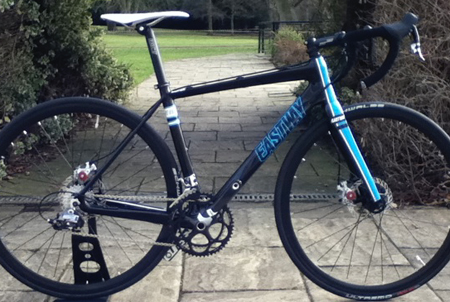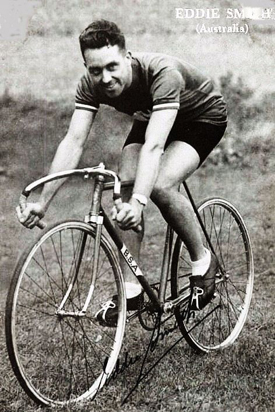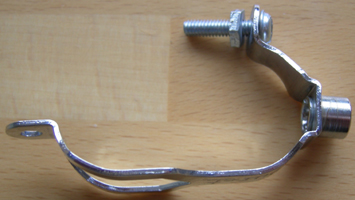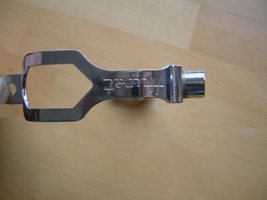Vol. 2, Issue 38 – March / April 2012
Posted: Tuesday 13th March 2012
Cycling in My Youth by Eric Hall – Part two
As you will read below, Eric started cycling when still at school and would have continued through until today. In September 2003 he was involved in an accident with a fast-moving car and while he has made a strong recovery physically, sadly the accident left him blind. Undaunted, Eric is still an active cyclist both on the back of a tandem and taking part in roller racing competitions. Eric also has a Healey Silverstone and still participates in international vintage car events using a friend to drive his beloved car.
In October 1952 the RAF decided that I was needed for my country, so I got called up. Now fortunately at that time the Air Force was very supportive of sports generally and cycle racing in particular. Throughout the summer, various RAF bases promoted road races or time trials. So I was based at Kidlington near Oxford for most of my service, or certainly for that first year. I joined the Oxford City Road Club as a second claim member which enabled me to ride their evening time trials on the Bicester road. I eventually got down to the dizzy speed of 1 hour 3 minutes for a 25, which was still pretty much middle-marker stuff, even in those days. People like the Higginson twins were regularly doing 57 minutes and I think the record was probably even then about 56. However, this gave me an entry into lots of road races and at that time two or three of the soon to be Hercules professional team were members of the RAF. Fred Krebs, if I remember was one, and I think Dave Bedwell also rode occasionally.
Even more fortuitously, the RAF, because at that time the Cold War was going on, had its own anti-counter espionage authority that it kept very hush-hush and one of the officers I worked for, I was only a humble clerk, was sent twice a year to conferences in France. He spoke very little French, but having discovered that I had an A level and spoke a bit of French, he took me along as an interpreter. This was very beneficial as I was allowed to take my bike with me and indulge in some cycle racing while I was there. This meant that in the spring I used to have about 3-4 weeks at Arras in the Pas-de-Calais, and in September 3-4 weeks in Fontainebleau, not very far from Paris. I’d now uprated the gearing system on the bike to a Simplex JUY51, which to my mind is still a very good gear and gave very wide ratio coverage. You could run the 13-26 block and still have 10 teeth difference on the chain rings, which was very useful.
So I was now riding 14-16-18-21-25 on the block and for most of it had 48-52 rings giving me a range of 51 to 100 inch gears. For touring I’d take the big ring off, the 52, fit the 48 on the outside and put a 45 on the inside, which was as small as you could fit to these Simplex competition rings at the time. And for riding behind Dernys I’d fit a 52 ring on the inside and fit a 56 ring on the outside. The 56 tooth ring wasn’t a standard size but there was a little cycle shop in Arras that had a very good engineer who used to make them to order.
Anyway, there I was living in Arras with the officer attending this conference most days and having plenty of time off for cycling! I managed to take part in a couple of kermesse in northern France. One in Calais and one in Belgium around Ghent and in the Belgian one I actually had the honour of riding in the same race as Rik Van Steenbergen. He was quite a character was Rik. He was a fairly large powerfully built man who had an incredibly powerful finishing sprint – In fact if he was there at the finish of a road race you could virtually say it was going to be his.
Anyway, at the end of the race I rode with him, he had a very large American car, a Mercury as far as I can remember, and he used to open the boot lid and then he’d have lots and lots of goodies. Things like watches, tubular tyres, perfumes – all for sale. I think he must have been a bit of a part-time smuggler. I bought a very nice stopwatch complete with a handlebar clip. I think it was a Leonidus from memory for very little money, for about £3 I believe, which to be fair was probably about a week’s wages from my RAF money.
What was very upsetting when I finally had my accident in 2003 was that the watch and the clip were on the handlebars of the bike which the police took off as evidence in case I wanted to prosecute the car driver, and when my friend Ron went to pick the bike up some three months later, apart from having to pay a storage fee which I thought was a bit excessive, the watch had gone, as had the clip. Anyway, I didn’t win the race with Van Steenbergen surprisingly enough. I think I finished about half way down the bunch but at least I rode.
On another occasion I rode in the Circuit du Port at Dunkirk and in that event was Jean Bobet, Louison Bobet’s younger brother, and probably in his very early days Jean Stablinski as well. Again, I finished somewhere in the middle of the bunch but all good experience. And good experience in riding over cobbles and tram lines too which I found very, very dicey to start with but you soon got the hang of it. I used to use, in those days, Pirelli tubulars or occasionally Clements. They weren’t the cheapest but they had a very good file tread on each side of the central rib and gave quite good adhesion in the wet and when cornering.
Back in England, I was posted back to RAF Kidlington, and in June 1953 we had a Station sports day and we actually had a cycle race. Half a mile – two laps of the grass track. None of us had specialised grass track bikes, we just rode whatever we had. I had my 10-geared Frejus and one of the corporals in the Guardhouse was also a bit of a road racer and he had a road-racing bike. But I think we were the only two serious cyclists in the field of about a dozen. The rest rode sports bikes and at least four were on Raleigh 28 inch wheel roadsters. As luck would have it I actually won. And my prize, awarded by the Station Commander’s wife, was a cigarette case. In September of that year I managed to get three days off work whilst I was based at Fontainebleau to ride the three day amateur Tour of the Auvergne which was very pleasant but extremely hard. I don’t think I came anywhere but I did at least finish. Life in the Air Force went on very much this way for the two years. I did actually ride one NCU open road race in 1953 as well, around the Wantage area, as a member of the Oxford City Road Club team. Again, I finished but well, well down the field.
I got demobilised in Oct 1954 and started riding with the Addiscombe again. And many of us younger members were very keen that the club should affiliate to the BLRC so we could do a lot more open road racing. Unfortunately, the majority of the club were staunch RTCC people and when I put forward the motion at the club AGM at the end of 1954 that the club should affiliate it was defeated although not by such a large margin as one might imagine. What was very pleasant to notice was that the Club’s President, Charlie Davy, had been a very successful racer in his early 30s. I think he rode in the Olympics in Canada. The other very successful person was Ernie Mills, of the Bill Paul Pool Tandem Partnership. Both he and Charlie supported us very much having formed the Croydon Olympic. In fact, when we ran our first road race some years later Charlie Davey said to me, “Eric, what are you going to do for prizes?” I said, “Well, we’ll have to put our hands in our pockets.” He said, “No, no, I shall present the prizes”, and he gave a whole stack of prizes for the road race which I thought was pretty good.
I did very little track racing during my career and I didn’t have a track bike in 1954. But at the end of the season I thought, well I will buy a track bike. It’ll be useful for time trials as well. So I went to Leaders and saw Ted Woodall, and I’d drawn out a rough sketch of what I thought was appropriate. 73 parallel angles, about an inch and three quarter fork rake, 16 “ chainstay and 11” bracket height. Had a look and thought, yes that’s pretty much what I’d suggest he said. He’d build it for me. I think it cost me £12, which I felt was extremely good value. It was a lug frame, not welded, and I took to using that. In fact that year, I think it was Peter White and one of the other club members who talked me into entering the Surrey Centre 5-mile championship at Herne Hill, which I duly rode. I was terrified! I’d never been so close to other people in a bunch before and I finished, but more than that I can’t say.
At the end of 1955, I was looking for a cheap but reasonable light bike to turn into an everyday hacking bike because I used to ride to work every day. By this time I was working for the LCC, and living in Wallington. It was a 13 mile ride each way, which was good training, and the traffic wasn’t as bad as it is now, fairly obviously. Anyway, I was talking to Charlie Davey and he said, “Oh, I’ve got an old frame that’ll suit you”, he said. And at the next club night he produced his new Hudson, 22.5 inch frame. Very nicely made and quite light and I said, “Where did you get this?” And he said, “Well, I rode professionally for new Hudson in the late 30s” So I was very honoured to have it, but like an idiot, it was left in my parent’s shed at Wallington when I got married and moved out and I do not know what happened to it unfortunately.
A couple of years ago I (Ed.) acquired a titanium Van Nicholas Yukon for use as a winter bike. I thought that the specification was just about as good as it gets for the rigours of a winter bike with its rust-resistant titanium frame. Lately though I have seen some hybrid machines ridden around Cambridge equipped with disc brakes.
This set me thinking that the worse thing about winter riding is the filthy sludge which builds up round the rims due to the reaction of the brakes on the dirty alloy rims. For the rear wheel there is the added ingredient of oil sprayed out by centrifugal force to the rims from the drive. This mixture of oil, dirt, alloy and water, agitated by the brake blocks produces the most filthy goo ever found on a bike – woe betide you if any of this gets onto your clothes!
It is obvious that having discs at the centre of the wheels would stop the production of this gunge. I would consider a conversion, which I imagine would need new hubs, a problem that could be overcome by spending money on it. However, disc brakes need a ‘torque lever’ to anchor the calliper and I could imagine it is possible to construct a bracket to fasten this on the chainstay. The problem (in my mind) is the carbon forks – I don’t think they are built to take this ‘thrust’ from the braking action.

It seems I am just in line with modern thinking as, just a few days before this edition was published I saw that both Look and Eastway have exhibited road bikes with disk brakes.
Look have concentrated on the cyclo-cross market for the time being but Eastway have both cross and road bikes (above). Some of the larger companies are probably waiting for a UCI ruling as to whether these brakes will be allowed in international competition.
I was doing some research for a piece on Campag seatpins and reading Coureur for Autumn 1956, one of the first four produced by Jack Wadley. In it I came across a long piece (27 pages) relating to Brian Robinson’s ride in the 1956 Tour de France. I an interesting snippet he recalls:
“At first we were riding unsponsored; then Georges Courpry took us into his newly formed La Perle team; no wages – just the bike and the chance of a bonus in the case of a win … This is what the French call riding a la musette, and I should say that half the French pros and independents are riding on those terms.” It makes you wonder what the independents in the UK were getting for their efforts. Things are not that much better for some riders today. I was speaking to one rider who rode on the Continent in a team, supporting a world champion. Over the season they got no pay, just accommodation provided by the organisers of one event after the other. Near to the end of the season their bikes were snatched back by a company owed money by the team.
Brian Robison gave examples of the diets for the duration of the 1956 Tour when he rode for the Luxemburg Team, it makes interesting reading:
The first meal of the day 8.30 – 8.45 or at least two hours before the start of the stage.
Thick vegetable soup to which had been added wheat germ and a preparation called Vita Levure.
Two slices of cold ham and tomato salad with olive oil.
Underdone beefsteak.
Lettuce and dandelion salad.
Creamed rice.
Stewed fruit (apples, pears, etc.). (Among forbidden fruits were apricots and strawberries.)
Weak tea (half tea, half milk)
One digestive tablet.
During the race two or three musette feeds. At the start we filled our pockets with the contents of the musette taken from the table at the starting control. The second was taken up from our manager during the race. If the race was long there would be a third towards the end. The food was standard and was provided by the organisation. A musette contained:
Leg of chicken
Two milk-bread sandwiches of ham
Two milk-bread sandwiches of jam
Four two-inch squares of rice
Two fruit tartlets
Three peaches
Two bananas (whoppers!)
Two packets of dried prunes
One orange
Twenty pieces of white sugar (I always replaced mine with brown lump sugar)
One piece of chocolate (only when raining or cold)
Drink – At the start, one bottle of lemon drink and one bottle of Milkor with twenty sugar lumps added. (Milkor is an Ovaltine-like vitamin preparation containing chopped-up fruit …) This was the drink for the first feed on the road. For the second feed it was just lemon drink (one or two on our team preferred beer). In my hip flask I had strong, well-sugared black coffee).
After the stage – A small bottle of Perrier water at the finish (two if you could grab another!) In your bedroom you would find waiting for you one litre of milk (1¾ pints). This allays hunger, gives a lining to the stomach, but does not destroy appetite. Two hours later, after massage and cleaning up, the following meal:
Soup, same as morning.
Hors d’oeuvres of grated raw carrots, diced beetroot, tomato salad, green beans.
Fish (if stage town near sea).
Ham (otherwise)
Veal, veal liver, or chicken.
Salad. Cooked beans, carrots, potatoes (I usually skipped these vegetables, having preferred the hor d’oeuvres).
Yoghourt (well sugared).
Fruit salad.
Red wine with sugar or glucose added, and Vittel water (a little wine is excellent for digestion).
On rest days the mid-day meal was similar to the normal evening menu, while breakfast, of course, was much lighter than on race days. (Ham and tomatoes are my favourite.) Each main meal eaten by a rider cost the organizers 1,500 francs (30/-) and at that price one can eat well.
You will notice one striking omission from the menu: eggs. On arrival at the hotel many hours before the riders arrived, the soigneur would go through the menu with the owner. Omelettes, egg mayonnaise, and anything of the sort, were immediately wiped off the list. A few other banned items were olives, pickles, sauces, gravy, pork of any description.
The taking of salt also was not encouraged, and strangely enough, though I sweated pints every day, I never felt a craving for it.
It is interesting to compare this to the diet for today’s riders. Whereas Brian had rare-cooked steaks (and an indigestion pill to cope with it) riders today seem to exist on pasta, pasta, or more pasta – all washed down with nutrition drinks.
Enclosed here a picture of Eddie Smith who was teamed with Joe Buckley in the 1937 Wembley 6 Day. Both riders were Australian and retired during the race.

The 1937 race was called the Coronation Six but was unique in the fact that the Magen David (Star of David) raced the Swastika. Lou Cohen was partnered with Jerry Rodman, both from the USA , racing in a Stars & Stripes jersey with a Star of David emblem on it. Toni Merkens and Gottfried Hurtgen, both German, raced in a red jersey emblazoned with a Swastika..
The Germans were placed eighth at 4 laps down with 446 points and the Jewish Americans tenth 7 laps down with 363 points. The race was won by Piet Van Kempen partnered with Albert Buysee.
Lou Cohen (USA) was an excellent 6 day rider who was very popular with the crowds due to his courageous and plucky riding. He won only one 6 day – the 1935 Buffalo race with Dave Lands.
Jerry Rodman (USA) was a popular rider from Chicago who won two Sixes: Montreal 1936 with Ray Bedard and the 1937 San Francisco event with Cecil Yates.
Gottfried Hurtegen (Germany) was born in Cologne, 27th November 1907. He was a superb sprinter, very strong in the chases and a great partner to his dear friend Victor Raush, with whom who rode many Sixes.
Here are his Six Day victories:
- 1928 Cologne (V.Raush)
- 1930 Berlin (V.Raush)
- 1930 Cologne (V.Raush)
- 1930 Dortmund (V.Raush)
- 1931 Stuttgart (V.Raush)
- 1937 Buenos Aires (Karl Gobel)
- 1937 Buenos Aires (Karl Gobel)
- 1940 Buenos Aires (Rafaele di Paco)
Albert Buysee rode a Claud Butler for a time during his career. Toni Merkens rode both on Claud’s and Hetchins and Piet Van Kempen also rode a Hetchins at sometime during his career.
Eddie Smith rode for B.S.A and Malvern Star.
The Eddie Smith postcard shown above is from my collection.
Steve Griffith
How do you fit a double down tube lever if you only have a frame with a single right-hand braze-on boss? If you use a double clip on it will look unsightly with the single braze-on unused. This convertor enables you to use a double braze-on. You leave your single right-hand braze-on lever as is and fit this with the large open section fitting around the base of the existing braze-on. Then you can use a matching left lever on the other side. I have a few of these for sale – email griffith531(at)hotmail.com


Mis-matched Components
When recently cleaning up a Chater-Lea crank on an unknown (to me) chainring a friend commented, ah Gnutti on Chater, a classic combination. This got me thinking about other mis-matched combinations that riders favoured. Others that come to mind are:
- Universal levers with Mafac centre pulls
- Stronglight 49D cranks with TA rings
- Simplex retrofriction levers and Campag gears
- Titan stems on Maes Kint bars
I suspect some were just fashion, or maybe driven by availability. Maybe there was a simpler explanation: the replacement component was cheaper. In other cases the mismatched parts offered superior performance, e.g. Simplex retrofriction levers were superior to Campag ones as they did not slip and changed with the lightest of touches. Can anyone think of other examples and any reason why???
And finally from Steve:
For sale – 21½” Lugless HOBBS Blue Riband frame re-sprayed yellow with metal head badge dated to Jan 1950 – £130
Bryan Clarke
Whilst idling away in the shed it has just dawned on me that the lower tension spring on the Gran Sport gear can be altered to improve overall capacity and of course improve the tension of a weakened spring. I knew that this was possible on the early Record gear but was completely ignorant with regard the Gran Sport. There are in fact three location holes for the spring in the outside jockey wheel cage. This is mentioned in a graphic maintenance page for the gear in an issue of Cycling magazine from 1962 when this gear virtually dominated the market and improved to take a six speed freewheel. Up till now I just accepted the gears as they came but any adjustment is very easy to do.
Chris Wimpey has a Bob Jackson, the serial # is 12173, he is having a difficult time determining the model and when it was built. He hasn’t been able to find an accurate serial number timeline, do you happen to know of one? He contacted B J but got no reply.
Roger Stevens has for Sale – CLAUD BUTLER 1949. 21½” frame, lugless. Probably ‘All-rounder’ or ‘Super-Velo.’ Re-sprayed with correct transfers. Steel cranks re-chromed. Fully restored.
4-speed derailleur. Simplex rear mech (1970’s ?). New headset & bottom bracket fitted; original parts available.
Free if required are the original Dunlop alloy rims. Rear carrier (c1960) fitted – not in pics.
Mark Hudson
The Classic Cycle Display, Sheffield will be held on the 16th of June 2012 at- St Mary’s Church, Bramall Lane, Sheffield, S2 4QZ
Times to be confirmed, but it will start in the morning, I expect 9 am, or thereabouts.
The first event will not have a theme. Members are invited to bring the machines of their choosing.
Emphasis is on vintage lightweights, but all types of curios and interesting bicycles are welcome.
I would like an idea of numbers. So if folk who are planning to show a bike/s could please contact me. As well as bicycles it would be nice to see some rare and unusual parts on display. So have a dig in your treasure chests. I have a decent sized lockable display cabinet for such items. Do any members have old cycling slides which I could show throughout the event? I’d like to carry the auction on, but I would like any funds raised to go to The Club.
For fuller spec. See https://www.classiclightweights.co.uk/bikes/claudbutlerwelded-rb.html Claud Butler welded 1949 (RS).
Posted: Tuesday 13th March 2012
This article appears in the following categories.
Upcoming Events
Whether you are looking for a gentle social meet up, or a 100-mile ride browse the community’s upcoming events and plan your next weekend outing.
